Introduction
The Starting Up of Demoskopea
The 1960s
The 1970s
The 1980s
Conclusions
Bibliography
Introduction
This article deals with a research project – still in progress – whose primary goal is to reconstruct the developmental stages of the second generation of Italian opinion research institutes. In particular, the study focuses on the history of Demoskopea, an Italian market research firm, and investigates that firm’s objectives, motivations and working methods, starting from their differences with Doxa, the progenitor of the enterprises operating in this field. The latter company was founded by Pierpaolo Luzzatto Fegiz.
The short methodological notes that follow, along with the contents of this article, grew out of a long-term dialogue with Giuseppe Paletta, Director of the
Centro per la Cultura d’Impresa in Milan. His expert advice, at all stages of the project up to now, has been my greatest source of encouragement in this work

.
The case study in this article is a demonstration of how researchers interested in the history of business– particularly small and medium enterprises – should take a few risks. They should not be stopped by the absence of an existing archives, especially when they have conducted a significant number of in-depth interviews (backed up by authoritative literature on the use of oral sources . Furthermore, this methodology allows the documentation – meaning the records that interviewees have kept – to emerge gradually (in this case, even many years after the interruption of the interviewees’ relations with Demoskopea
. Furthermore, this methodology allows the documentation – meaning the records that interviewees have kept – to emerge gradually (in this case, even many years after the interruption of the interviewees’ relations with Demoskopea . The enterprise, “a starting point for the collective memories of a group of economic actors”
. The enterprise, “a starting point for the collective memories of a group of economic actors” leaves the traces of its history through the collective action of all the people who contributed to its creation
leaves the traces of its history through the collective action of all the people who contributed to its creation . Perhaps, even more importantly, the enterprise determines its present identity in the same way. This is why I believe that memory influences the organization—a fact that entrepreneurs should not ignore.
. Perhaps, even more importantly, the enterprise determines its present identity in the same way. This is why I believe that memory influences the organization—a fact that entrepreneurs should not ignore.
This article shows the reader another “path” of information about the history of Demoskopea, adding other oral histories, both from the people already interviewed and from the people who will come forward after reading this article. In addition, the paper records – research notes, business magazines, and other documents –were reorganized by the narrators themselves during the interviews, thus making it possible to recreate an archives.
However, sources were not limited to the personal accounts of the subjects and their paper records. I also had the opportunity to consult the archives of the Business 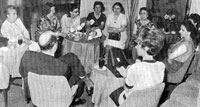 Registry Office of the Chamber of Commerce of Milan, essential to retrace the stages of Demoskopea’s life, from its startup in 1965. For reasons of brevity, this article will provide a summary of the company’s evolution, while a detailed description of each stage will be left to other publications.
Registry Office of the Chamber of Commerce of Milan, essential to retrace the stages of Demoskopea’s life, from its startup in 1965. For reasons of brevity, this article will provide a summary of the company’s evolution, while a detailed description of each stage will be left to other publications.
The Starting Up of Demoskopea
|
 |
The starting up of Demoskopea in July 1965 was the beginning of a new phase opinion surveys and market research institutes in Italy – both were fledgling initiatives at that time. In the years of Italy’s “economic miracle” we witnessed what Sandro Rinauro defined as “the birth of the second generation of the Italian opinion research institutes”

. An increasing number of market surveys was carried out, leading to their radical innovation in terms of methodology and strategy (reference markets, customers, perspective on a society in transformation).

Giampaolo Fabris and Carlo Erminero decided to create Demoskopea – together with Bartolo Mardesich, Mario Gola, Tullio Bonaretti, Rossana Locatelli, Nedda Penne – and established its headquarters in Via Podgora in Milan. Fabris had already gained experience with Attwood (an English company recently absorbed by Demoskopea) and in particular, with Doxa of Pierpaolo Luzzatto Fegiz, the man who introduced opinion research in Italy in 1946. Fabris could also count on a solid theoretical background from his professor at the
University of Pisa, the statistician Guglielmo Tagliacarne, author in 1951 – together with Luzatto Fegiz and George Gallup – of the first Italian handbook of market surveys.
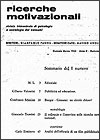
Carlo Erminero, also from Doxa, wanted to diversify Demoskopea’s method in the search for a new customer target. Together with Fabris, he marked out the strategic direction of the new market research institute, dealing prevalently with the methodology of quantitative research and its applications to the study of the editorial and advertising market.
Giampaolo Fabris’ thesis
Prospettive e limiti dell’applicazione delle ricerche motivazionali allo studio del mercato (Perspectives and limitations of the use of motivational research in market study) provided the “ingredients” of the changes to be implemented with the setting up of Demoskopea. Above all this meant shifting the strategic focus from opinion research to market research. Consequently, private customers were given priority over public ones - previously Doxa’s primary clientele. This is a fundamental point since it allows historians to observe the subsequent developments of Demoskopea, while referring constantly to intellectual and market factors.Fabris and Erminero had left Doxa because they were unsatisfied with its general profile. Together with Bartolo Mardesich (who left Demoskopea in 1967), they concentrated on the idea of an institute that put well-balanced qualitative and quantitative research at the service of the market. At the same time, they adopted new methodologies that appeared in Italy at the beginning of the 1970s, including the motivational research studies promoted by Ernest Dichter, whose work influenced several of the key personalities committed to the renewal of the field

.
Giampaolo Fabris, Francesco Alberoni, Gabriele Calvi (the founder of Eurisko in 1972), Giulia Camusso, Carlo Carli, Marino Livolsi are among the scholars who established links between the academic world and enterprise. Their efforts have been documented in numerous essays published in the magazine Ricerche motivazionali (founded by Fabris in 1964 and edited by Fabris himself);  as well as in Ricerche Demoscopiche - bimestrale diindagini sociologiche e di opinione pubblica della Demoskopea (whose first issue was published in 1969).
as well as in Ricerche Demoscopiche - bimestrale diindagini sociologiche e di opinione pubblica della Demoskopea (whose first issue was published in 1969).
Misura, the company founded by Piero Bassetti in Milan in 1959, building on the application of motivational research and on a clear quantitative basis, brought together several of these personalities, some of whom had joined Demoskopea in 1965; for example, Giulia Camusso, psychologist and motivational expert.
The 1960s
|
 |
The Italian market of the 1960s felt the strong presence of these three companies – Doxa, Misura and Demoskopea – at that time the field was not yet strongly competitive. However, it was necessary to acquire a private clientele, whose traditional priorities did not extend to investment in research

.
The first relevant contract for Demoskopea was a study on newspaper readership (today Audipress), which gave the company the chance to establish its institutional credibility and acquire new customers. At the same time, its internal structure was created with a functional division of the work. The pivot of Demoskopea remained with Carlo Erminero and Giampaolo Fabris as leaders; however, many future professionals such as Marilù Faustinelli Bonetti, Alessandro Cortellazzo, Anna Zamboni and Giorgio Villa began their careers there.
Erminero and Fabris’ skills complemented each other well. Erminero concentrated prevalently on developing the quantitative research, including a series of periodical or continuative services – like the Panel famiglie (I’ll return to this pont later), the Panel librerie for publishing houses such as Feltrinelli, Mondadori, Rizzoli, and studies on the advertising market and the credit world. In addition, he looked after most of the administrative aspects. Fabris, on the other hand, directed his attention to important targeted research studies, mostly qualitative.
Erminero pointed out the differences between Doxa and Demoskopea in those years. He insisted that Doxa, by focusing prevalently on analyzing public opinion through statistical research, had not developed a culture of services dedicated to enterprise—that is, a culture of marketing research

.
Doxa’s analyses of behavior, according to Erminero, neglected to investigate the underlying motivation of behavoir: this implied a lack of understanding of the described behaviors (something that would have been useful, even conclusive to the enterprises that requested the research ). This was a further reason that Fabris and Erminero left Doxa.
These were the years in which Giampaolo Fabris, combining his work in Demoskopea with a series of publications, developed one of his key theories, which became a ruling principle of Demoskopea: the need to analyze the individual as a premise for understanding consumer choice. The “consumer” itself doesn’t exist; the basis of study is the person in society (a starting point that is further clarified by Fabris’ association with George Katona, one of the founders of economic psychology).
Demoskopea gradually acquired new customers from various sectors including oil companies; they assisted the introduction of Total into the Italian market, and cooperated with Esso and Shell. The food industry was also relevant: Buitoni Perugina was the most important client of Demoskopea in this field. Over the years, Ferrero, Pavesi, Lavazza, Stock, Knorr and many other food companies employed Demoskopea’s services. Clients from other sectors include CGE, Candy, Unilever and Mondadori.
The company began to distinguish itself with the achievement of several large integrated research studies, and by building up a team of about seventy new employees who came from other enterprises or were new graduates interested in motivational research (a few of them eventually set up their own businesses). Despite rising costs, Demoskopea also invested in expanding the business, stimulated by the growing importance that the enterprise had gained on the market.
One of the driving activities of Demoskopea was the OTP research – a periodic research carried out on a national level, regarding the readership of newspapers. This study was prevalently financed by editors and advertising agents and played an ambivalent role in the development of the company. On the one hand, the OTP study gave Demoskopea the opportunity to use the most advanced methodological instruments of the second half of the 1960s; on the other hand, following a decision of the editors in 1972, the study was suddenly interrupted, forcing the company to dismiss one third of the employees, exactly at the point when the substantial investments were beginning to show returns.
The 1970s
|
 |
The coincidence with the general economic crisis at the beginning of the 1970s, often mentioned in the reports attached to the balance sheets, did not stop the development of Demoskopea which, in the meanwhile, transferred and enlarged its headquarters, from Via Podgora to new offices in Via Majno. The succession of events in the editorial market wove together with the path of the company, starting long-term relations that can be considered “windows” on the transformation of Italian society. Demoskopea often publishes polls in L’Espresso – which the magazine usually features on its cover – for example, for various political elections, including the President of the Republic (1971) and on the divorce referendum (regarding the Fortuna-Baslini law in 1974).
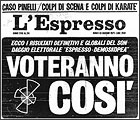
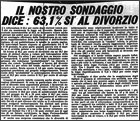
Demoskopea also carried out research regarding the choice of the name, the positioning and launching of the daily newspaper, La Repubblica; for Il Giorno, the company investigated the reaction of readers to the introduction of color images in the newspaper; it directed readership studies for La Stampa (with external consultants, Stefano Draghi – professor of quantitative methods for social research – and Angelo Pagani), as well as the editing of La Stampa’s featured classification of books, Tuttolibri.
In the second half of the 1970s, Demoskopea’s opinion polls were frequently commissioned and published by Panorama. Besides pre-electoral research on a particularly large representative sample (before the elections of 1977 and 1979), the weekly newsmagazine published detailed reports of polls on a number of topical issues such as the transformation of the traditional family, on abortion (in cooperation with Emma Bonino’s Cisa) and on the changing composition of the university.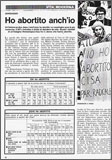
Even though Demoskopea tended to favor its relationship with the market and its corporate clientele, its cooperation with the major print media institutions – together with appearances on RAI 2 (national public television) for the electoral projections of 1979 – represented the trait d’union with the political sphere that had begun to look at the polls with new eyes (even the Left, traditionally suspicious and highly skeptical of opinion surveys), giving rise in the following years to sondomania (poll mania) a phenomenon that this short article cannot cover, except to mention as one of the transitional characteristics of Italian society in the 1970s.
At this point, it is important to point out that the case of Demoskopea demonstrates the permeability of the research institution to the cultural and economic currents that characterize society and the business world. In the period between the two world wars, Italian private enterprise was slow to accept techniques for streamlining production and rationalizing distribution. It is enough to consider – and here we can underline Demoskopea’s efforts to address its clients – the Italian market’s delay in adopting research for the planning and the efficiency of advertising. In this field Demoskopea intervened, above all in the editorial market, with a periodic control on printed advertising – IPS – thereby creating a database of thousands of advertisements, and
engaging researchers to define accurate profiles of the readers to be interviewed. The Omnibus investigations, widely used by Demoskopea since 1975, also made up for private enterprise’s meager investment in research.
The same questionnaire, administrated to a large number of families and individuals through one-on-one interviews, included questions created by different clients. Consequently, the results gave marketers the opportunity to verify preferences, buying habits, and consumers’ recall of

advertising.
In the 1970s the Panel Famiglie were created for the study of behavior and of evolution, with a possibility of large scale analysis. Demoskopea had already accomplished several motivational research studies. We can mention the survey for
Zanussi (household appliances), conducted in 1969, whose aim was to verify the attitude towards possible production and commercialization of the first VCR. In this case, 60 interviews were conducted in various Italian towns by consulting psychologists, followed by group meetings. The results of the survey portrayed the attitude of consumers towards television and other mass media and covered the entire life of the products (expectations of the consumers concerning product function, chains of distribution, prices and the importance of the possible product names).

To Demoskopea, motivational research on the evolution of the market implied the study of individuals, and the broad scope of the surveys often gave the reader a cross-section of a society in transformation. During the national conference “Il mercato e la donna” (“The Market and Women”) (Genoa, 21-23 November 1968), Demoskopea presented a research study,
La donna consumatrice (The Woman as Consumer), that analyzed – together with the progressive widening of women’s role as decision-maker in buying – significant changes of her role in society regarding the family, work and leisure. Fabris, in his introduction to the presentation of the research, coordinated by Giulia Camusso, criticized the “…new myth (but old model) of the woman as home-maker”.

The abovementioned examples, represent only a small part of Demoskopea’s activities; however, they allow us to understand the importance that the company placed on adopting the 3SC method, a monitoring system started in 1977, first proposed to a large group of leading Italian companies – including
FIAT – and considered by Giampaolo Fabris as a new way of studying the market: first, analyzing social trends; then, offering scenarios of change to companies, tailoring them to specific fields

(fashion, automotive, etc) with the possibility for clients to include questions pertinent to their needs.
Demoskopea’s cooperation with public television, began at theend of the 1960s, and followed different paths: the RAI Opinion Service commissioned surveys regarding, for example, television and young children,
Televisione e bambini. L’ascolto della televisione da parte dei bambini da 0 a 3 anni (1975).The same service transcribed, for internal use only, summaries of Demoskopea
polls published in magazines (in 1970, the results of a poll related to the behavior of young people was published in
L’Espresso).


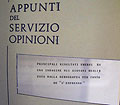
In the 1990s, cooperation with the RAI continued both through appearances on TV of Demoskopea members and polls commissioned by the public service (
Gli italiani e la televisione, 1996;
Tivù delle mie brame. Quello che gli italiani guardano e quello che vorrebbero guardare, 1996;
La riorganizzazione dei palinsesti di Radio RAI, ipotesi “grafiche”, 1999).

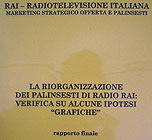
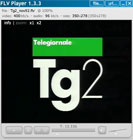
Moreover, we should not neglect to mention Demoskopea’s work in the banking field: research carried out for
ABI(Associazione Banche Italiane) for the launching of ATM services in Italy as well as marketing studies
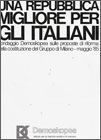
for the
Banco di Napoli , directed by Carlo Erminero.
A further example of the attention Demoskopea places on examining ideals in the society is to be found in a project accomplished in the 1980s:
Una Repubblica migliore per gli italiani. Sondaggio Demoskopea sulle proposte di riforma della Costituzione del Gruppo di Milano (coordinated by Gianfranco Miglio),
maggio 1985
. I spoke about the
international scene.
Since 1970 Demoskopea has collaborated in the creation of the ESOMAR/CCIA code (a professional code of the European researchers); and has participated in the development of an international network – the RISC – of companies with similar work methods and inputs. In 1980 it entered the IRIS network formed by European institutes to coordinate international motivational research. In addition, it established links with

the
Sherman-(USA) group and the Mori group

.
The 1980s
|
 |
The end of the 1970s was characterized by periodic financial instability and repeated increases in capital, with low profit margins. In 1980, Demoskopea once again changed its headquarters to the offices of Via Bixio. In the following years, Giampaolo Fabris left Denmoskopea (in 1983 he decided to leave the board of directors)

and new people started working in the enterprise that, in 1986, signed license agreements with the AIM-Sherman group and obtained the most important Italian research on the editorial world – ISPI and ISEGI – transforming its operative structure (three new branches: marketing, editorial and communication) and creating a specific section for motivational research. One year later, Demoskopea participated in the setting up of Computel (phone surveys; the company was merged in 1990) and, after new augmentations of the capital, it became a limited company

.
Conclusions
|
 |
As mentioned at the beginning of this article, my intention has been to outline some starting points for a study on the “second generation” of the Italian opinion and market research institutes, begun in the 1960s with the setting up of Demoskopea (with a significant change in direction from its progenitor, Doxa) and in 1972, Eurisko, founded by Gabriele Calvi. The evolution of these enterprises as “receptors” of social change, throughout the 1960s, 1970s and 1980s gives us the opportunity to understand the signs of broad cultural transformation and the shift in consumer orientation. With careful comparative study, we might also find reasons for the delayed participation of Italian companies in marketing oriented production and market research.
Finally, the case of Demoskopea and other “second generation” marketing and public opinion enterprises helps to clarify the phase– between the economic boom and the crisis of the 1970s – in which the shrinking of the market should have induced companies to make use of the instruments provided by market research. This happened only partially. It is to be hoped that current fragmentation of market research and opinion surveys (other than the recurrent debates on “sondomania”) may encourage further study.
Bibliography

